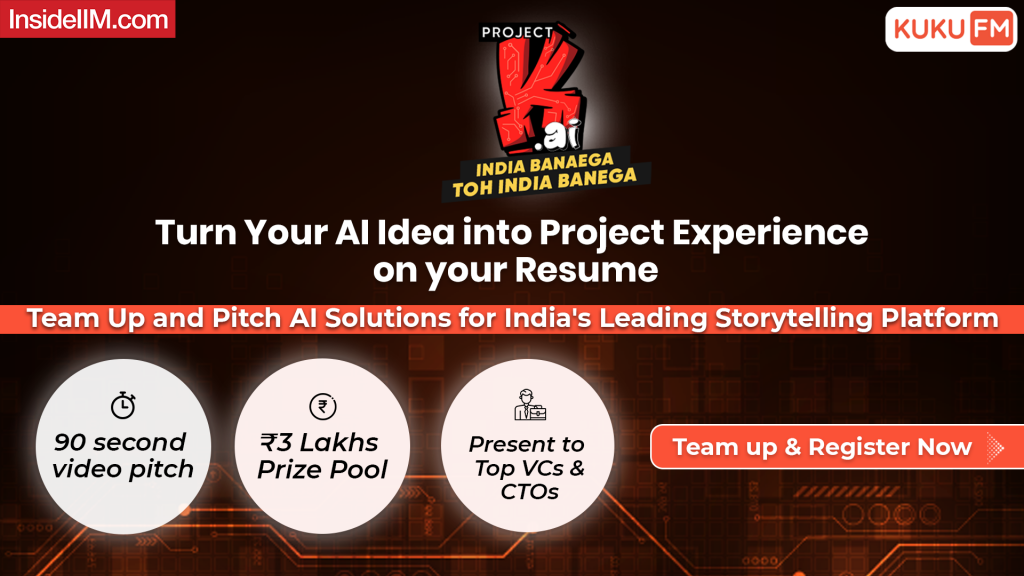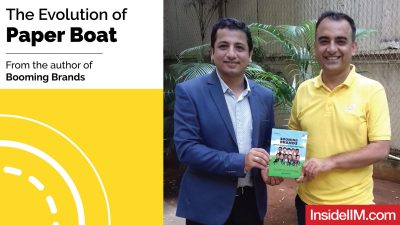Launched in August 2013, Paper Boat is one of the fastest-growing FMCG brands in India. In 2016, AFAQs ranked Paper Boat among the top 10 buzziest brands of India, and in 2017, Interbrand recognized Paper Boat as a breakthrough brand.

To know about the journey of Paper Boat, we interviewed Harsh Pamnani, who is an alumnus from XLRI Jamshedpur and author of the bestselling book Booming Brands (published by CNBC). In his book, he has covered inspiring journeys of many new age ‘Made in India’ brands, including Paper Boat.
You'll be seeing more of our interviews with Harsh in the coming days, as he details out his learning from some of the biggest and hottest brands made in India!
***
Debayan: How did you get the idea of writing Booming Brands?
Harsh: Debayan, first of all, I would like to say thank you to InsideIIM and you for giving me this opportunity! During my MBA, the majority of case studies & examples I read in marketing courses were of international brands. India is not America, and the way brands were created in developed countries like America, can't be created in developing and diverse country like India. I met many professors and students who expressed that there is enough material available on growth stories of international brands, but not much has been written about growth stories of Indian brands, especially the new-age ones that have emerged post-liberalization and in the digital era. Noticing this void, I felt I could come up with some referable material that could be leveraged by people interested in learning from the journeys of today's rising brands. I am grateful to all the brands and the people who helped me in my journey.

Debayan: How is Booming Brands different from numerous other marketing and entrepreneurship books available in the market?
Harsh: There are many excellent books and case studies written by both international and Indian authors on the topics of marketing, brand management, and entrepreneurs' journeys. The purpose of this book is not to become a substitute or supplement of any of the available material. It is a passionate initiative to share the learnings on brand building along with the backstory of a few entrepreneurs who built something out of nothing in a highly complex, crowded, and competitive market - India.
Booming Brands provides answers to burning questions like:
- How were new age admirable brands created from scratch?
- How did these brands achieve popularity in a highly crowded and competitive market?
- How did entrepreneurs behind these brands identify new opportunities and create million-dollar markets?
The lessons derived from the hard-earned success of the brands covered from multiple industries and domains can help MBA students, aspiring entrepreneurs, and marketers, to carve out their own journey and brand strategy.
Debayan: Tell me why you covered Paper Boat in your book?
Harsh: In today’s super crowded and highly competitive marketplace, dozens of new FMCG brands are launched every day. Within FMCG, if we look at the beverage category, bigger players such as Coca Cola, Pepsi, and Dabur have been present in the market for years with their huge customer base, distribution network, and resources that are difficult to match. In such a tough market, a start-up – Hector Beverages has rewritten the rules of the game and has built a strong packaged beverage brand – Paper Boat. Paper Boat has touched the pulse of Indian customers by providing ethnic Indian drinks through its authentic recipes and alive packaging. Hence, I was curious to know about the brand’s inspiring journey and marketing strategies.
Debayan: Tell me a little about how Paper Boat got started?
Harsh: Paper Boat’s parent company Hector Beverages was founded in 2009 by Neeraj Kakkar, Neeraj Biyani, Suhas Misra, and James Nuttall. Before Paper Boat, the founding team had worked long and hard on various drinks categories such as protein and energy drinks.
The journey of brand Paper Boat started with the search for one of the traditional drinks,
'Aam Panna.' The company's co-founders, while having lunch used to enjoy homemade
'Aam Panna,' brought by Suhas. They wanted to have more of it and wanted to share it with others. They searched a lot for it in the market, but they couldn't find this drink anywhere. During this search, they also found that many traditional home-made drinks, which they enjoyed a lot during their childhood, were not available in the market.
They realized that traditional drinks were slowly vanishing from people's lives. With an objective to preserve traditional drinks and make them available in hygienic and packaged form, they planned to launch their own ethnic beverage brand. The team first test-marketed the product in Feb 2013 and then nationally launched the brand Paper Boat in August 2013 with two flavours –
Jaljeera and
Aam Panna.
Debayan: Paper Boat is a very catchy name. How did the team come up with this name?
Harsh: The team wanted to evoke childhood memories through packaged ethnic Indian drinks, so they decided to come up with a brand name that could instantly connect people with their childhood memories. All children make paper boats. The process of making paper boats in the monsoons is one of the happy childhood memories. Hence, the brand name Paper Boat appeared as a perfect fit.
Debayan: Can you tell me about a few innovative strategies that contributed to the growth of Paper Boat?
Harsh: Actually, there are many strategies that I have covered in detail in my book. Let me share a few of them briefly:
New category: Before the launch of Paper Boat, the Indian soft drink market was filled with categories such as carbonated drinks, sports drinks, energy drinks, juices, and juice-based drinks, etc. Most often, companies introduce new brands in established categories and try to promote these brands. However, even after spending a lot of money, these new brands are not able to develop their recall value as their categories are already crowded with established brands. One of the best ways to create a powerful brand is to create a new category where you can be first in. As there was no category covering ethnic Indian drinks, Hector Beverages picked this opportunity and filled the gap by launching Paper Boat.
Great product: A great product is the foundation of a great brand, and best in class ingredients are the foundation of a great product. All the Paper Boat drinks are made without preservatives, added colours, or carbonation. These drinks are prepared using local spices, fruits, flowers, and pulses. Hector Beverages has been very selective in terms of partnering with suppliers who can provide the best quality ingredients. To continuously innovate and make its products better, the company has its R & D center based in Bangalore. At this center, at a time, research on 15 new products happen simultaneously. It takes around two years for a product to hit the market.
Effective packaging: Packaging is the first point of contact with customers at the point of sale. Paper Boat’s packaging is interesting, innovative, and informative. It enables the serving of a traditional drink in a modern way and stands out in a cluttered market. For differentiation and authenticity, Doy packs that look and feel like paper have been chosen. These packs provide a unique experience of gripping, holding, and drinking the product. They are light, compact, and easily transportable. Even the cap of the package is an innovation. The packaging graphics reflect the simplicity and purity of the drink inside.
Differentiated distribution strategy: Distribution is one of the key aspects of the marketing strategy. Usually, new beverage brands try to convince departmental stores and kirana stores to stock their products. But kirana stores have only one cooler, and departmental stores are already filled with many established brands. Initially, instead of following the regular route, Hector Beverages approached Indigo airlines for distribution partnerships. Through this partnership, Paper Boat was able to get the attention of air travellers during their private and captive time. Later, the company partnered with modern retail stores such as Big Bazaar and Reliance Fresh, followed by partnerships with coffee chains like Barista Lavazza, hotels like Westin and Trident, and companies like Google, Facebook, LinkedIn, and others.
Debayan: Beyond the strategies you shared in your previous answer, I am curious to know what other factors would have helped the brand to earn credibility in the market?
Harsh: People infer that a start-up is credible if it has ingredients such as experienced leaders, backing from known investors, coverage by popular media channels, word of mouth by influencers and acceptance by reputable distribution channels. Let me briefly share with you a few of the factors that have helped Paper Boat.
First & foremost, Hector Beverages' leadership team has impressive credentials and relevant experience in various areas of business. For instance, the company's CEO, Neeraj Kakkar studied two MBAs spaced ten years apart, one from Management Development Institute (MDI), Gurgaon, and the second one from The Wharton School, the University of Pennsylvania before co-founding Hector Beverages. Between his MBAs, he spent a large part of his corporate career with Coca-Cola. He has also been a speaker at many popular and prestigious conferences.
Then, Paper Boat’s marketing campaigns are focused on building relationships with the target audience through storytelling and have followed a distinctive tone of creating nostalgia and innocence around childhood memories. Also, the brand has received a lot of favourable coverage at reputed media platforms such as Forbes and Mint. It has also been covered extensively via various bloggers.
The brand has also earned backing from many marquee funds. Right at the beginning, in 2011, the company raised funds from Infosys founder N.R. Narayana Murthy's venture capital fund Catamaran Investment. A few other leading venture capital firms such as Sequoia Capital have also invested in the company. Furthermore, positive mention by luminaries like Vir Sanghvi and Harish Bhatt in their posts, and recognition from many renowned platforms have contributed to the credibility of the brand.
Debayan: Can you share one piece of advice that Neeraj Kakkar shared with you for Booming Brands’ readers?
Harsh: Look at marketing not as a one-way dialogue, but as a way to engage customers in meaningful conversations.
Harsh Pamnami With Neeraj Kakkar (CEO, Hector Beverages)
***
Stay tuned for our upcoming conversations with Harsh!




